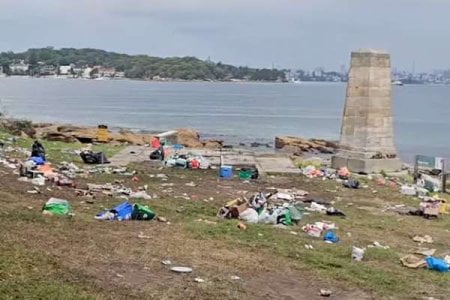Authorities slam ‘inconsiderate visitors’ after yet another environmental disaster
By
Maan
- Replies 8
Public spaces are meant to be enjoyed by everyone, but what happens when reckless behaviour leaves them in a state of ruin?
A concerning trend has seen some of Australia’s most scenic locations repeatedly trashed, sparking outrage among locals and authorities alike.
The latest incident has once again highlighted the ongoing struggle to protect these natural spaces from thoughtless destruction.
A Sydney coastal park was left in a disgraceful state after an out-of-control gathering saw hundreds of partygoers abandon mountains of rubbish, sparking fury among locals and officials.
Authorities condemned the mess left at Sydney Harbour National Park in Vaucluse, where an estimated 300 people held an unauthorised party over the weekend before disappearing and leaving behind significant waste.
Footage shared on social media showed piles of litter scattered across the area, with frustrated residents saying this was not an isolated incident.
Sydney Harbour National Park includes Camp Cove, Green Point Reserve, and Nielsen Park, all popular spots frequently targeted by careless visitors.
A spokesperson for the NSW National Parks and Wildlife Service (NPWS) confirmed the event had been shut down by police, but the damage had already been done.
‘This is the result of an unauthorised party of approximately 300 people on the weekend,’ the spokesperson shared.
NPWS staff were forced to clean up the aftermath, which the spokesperson described as ‘very disappointing and unfortunately not unique.’
The spokesperson also stated that rangers routinely deal with litter left by ‘inconsiderate visitors.’
‘We encouraged everyone to think about the impact, and dispose of their litter appropriately,’ they said.
Similar incidents have plagued parks and coastal areas across Australia, with rangers and locals often left to clean up the destruction.
Commonly abandoned items include empty alcohol bottles, plastic cups, food packaging, eskies, and even broken furniture.
Despite ongoing enforcement and fines for littering, the problem has persisted, with some locations suffering repeated damage.
Locals expressed outrage online, with one person writing, ‘Leave no trace. How hard is it?’
‘So disrespectful to leave this,’ another said, while others called the behaviour ‘disgusting’ and ‘repugnant.’
Environmental groups have long warned that discarded rubbish poses a serious risk to wildlife, with glass shards, plastic debris, and food waste attracting animals that can become sick or injured.
Even with crackdowns, warnings, and penalties, the cycle of destruction has shown little sign of stopping.
Recent cases have illustrated the devastating consequences of human pollution, including the death of a platypus in Western Sydney last month after it became entangled in discarded fishing gear.

With careless littering continuing to threaten Australia’s natural spaces, what more can be done to stop this cycle of destruction? Let us know your thoughts in the comments.
A concerning trend has seen some of Australia’s most scenic locations repeatedly trashed, sparking outrage among locals and authorities alike.
The latest incident has once again highlighted the ongoing struggle to protect these natural spaces from thoughtless destruction.
A Sydney coastal park was left in a disgraceful state after an out-of-control gathering saw hundreds of partygoers abandon mountains of rubbish, sparking fury among locals and officials.
Authorities condemned the mess left at Sydney Harbour National Park in Vaucluse, where an estimated 300 people held an unauthorised party over the weekend before disappearing and leaving behind significant waste.
Footage shared on social media showed piles of litter scattered across the area, with frustrated residents saying this was not an isolated incident.
Sydney Harbour National Park includes Camp Cove, Green Point Reserve, and Nielsen Park, all popular spots frequently targeted by careless visitors.
A spokesperson for the NSW National Parks and Wildlife Service (NPWS) confirmed the event had been shut down by police, but the damage had already been done.
‘This is the result of an unauthorised party of approximately 300 people on the weekend,’ the spokesperson shared.
NPWS staff were forced to clean up the aftermath, which the spokesperson described as ‘very disappointing and unfortunately not unique.’
The spokesperson also stated that rangers routinely deal with litter left by ‘inconsiderate visitors.’
‘We encouraged everyone to think about the impact, and dispose of their litter appropriately,’ they said.
Similar incidents have plagued parks and coastal areas across Australia, with rangers and locals often left to clean up the destruction.
Commonly abandoned items include empty alcohol bottles, plastic cups, food packaging, eskies, and even broken furniture.
Despite ongoing enforcement and fines for littering, the problem has persisted, with some locations suffering repeated damage.
Locals expressed outrage online, with one person writing, ‘Leave no trace. How hard is it?’
‘So disrespectful to leave this,’ another said, while others called the behaviour ‘disgusting’ and ‘repugnant.’
Environmental groups have long warned that discarded rubbish poses a serious risk to wildlife, with glass shards, plastic debris, and food waste attracting animals that can become sick or injured.
Even with crackdowns, warnings, and penalties, the cycle of destruction has shown little sign of stopping.
Recent cases have illustrated the devastating consequences of human pollution, including the death of a platypus in Western Sydney last month after it became entangled in discarded fishing gear.
Key Takeaways
- A Sydney coastal park was trashed after an unauthorised party of 300 people, leaving locals outraged.
- NPWS rangers cleaned up the mess, calling it ‘very disappointing and unfortunately not unique.’
- Similar incidents across Australia have led to repeated destruction despite fines and enforcement.
- Environmental groups warn wildlife is at risk, with recent cases highlighting the dangers of human pollution.
With careless littering continuing to threaten Australia’s natural spaces, what more can be done to stop this cycle of destruction? Let us know your thoughts in the comments.








